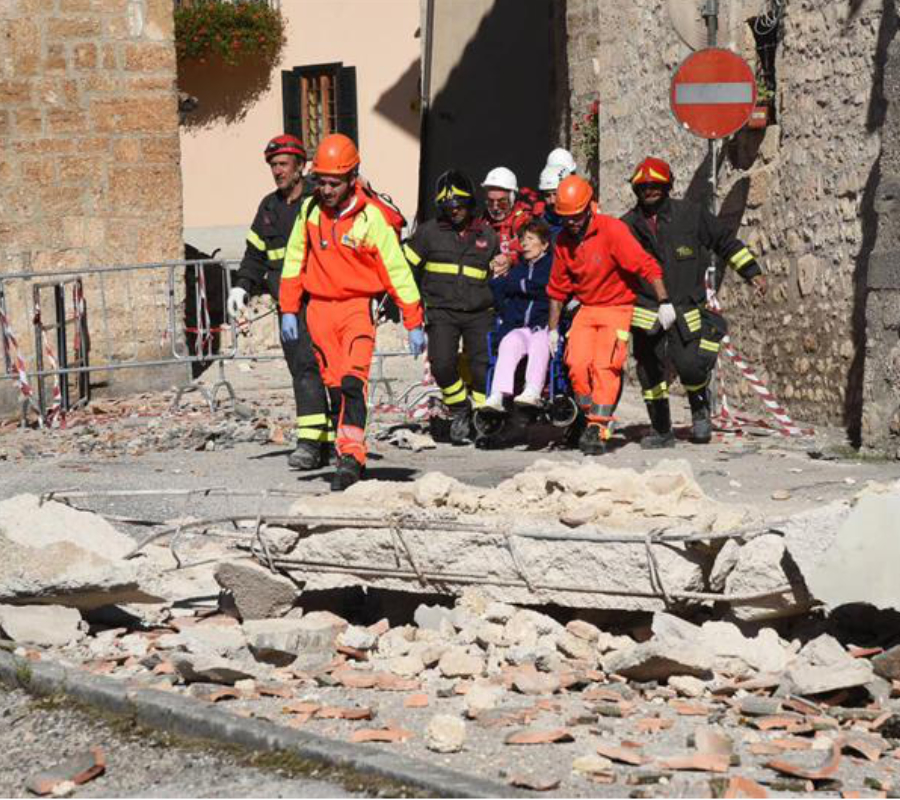Another earthquake has hit Italy, but this time the country was prepared for it, and prevention labors have saved hundreds of people. Norcia, a small town in center Italy, has been the most affected area. The quake shook lands north the Alps and as far south as Rome, covering an area of 90 kilometers (56 miles).
So far 20 people have been injured, and no deaths have been reported. The 6.6-magnitude quake is the strongest to hit the country in more than three decades. The earthquake began Sunday at 07:40 a.m. local time (02:40 a.m. ET). The natural phenomenon struck at a depth of 10 kilometers (6.2 miles), according to the U.S. Geological Survey. The agency reported that the epicenter was relatively shallow. The more shallow the epicenter, the more a quake is felt by people at the earth’s surface. Shallow epicenters are most likely to cause severe damages.

Sunday’s event came after several tremors that happened Wednesday, which warned Italy to take precautions in case of a stronger quake. When the earthquake started, people ran onto the streets, some in panic and some in calm to evacuate the buildings. Norcia is an isolated town mostly visited for its religious architecture, but the quake destroyed most of the city’s patrimony.
Authorities do not expect many deaths nor injured people because after this week’s temblors they evacuated most residents to emergency camps and hotel rooms. The government paid for all the arrangements. Schools were shut down in anticipation of another earthquake to avoid a new death toll, a fortune that victims of the August quake in Amatrice did not have.
Rescuers arrived at Norcia soon after Sunday’s earthquake started to shake center Italy’s surface. They worked through aftershocks that hit the region every 20 minutes approximately. Italian Prime Minister Matteo Renzi has thanked rescuers for quickly helping people.
The Prime Minister also promised to rebuild damaged villages and restore the churches and other structures that are part of the Italian cultural heritage.
“We will rebuild everything. We have the resources to do it,” said Renzi to Italians.
Even if Norcia and other villages did not lose someone in the quake, they lost an important part of their culture. Many of the historic buildings could not be reinforced due to the strong temblors that struck the center-Italian regions Wednesday. The Basilica of San Benedetto in Norcia, the most visited in the town, was destroyed. Only its facade resisted the quake, but not quite.
People are fleeing the affected villages fearing another shake
Italians are trying to get as far as possible from the affected regions, while others refuse to leave their hometowns. Those who wish to stay are sleeping in their vehicles, thinking they offer more protection than solid roofs and other structures.

“These people don’t want to leave their area because they are really linked in. There’s a long tradition there, and they have some jobs, farmers and so on, so they decide to stay there,” Tommaso Della Longa of the Italian Red Cross told CNN.
Della Longa added that people trying to stay near their homes are in danger because of the weather. Norcia and the other affected towns are located between mountains and valleys. It is already cold in those regions and snow is coming in a few weeks. If those who refuse to leave are somehow victims of the climate or unstable structures, rescue teams will not be able to get there as fast as they should because the roads to get to those areas have been destroyed by the quake.
If those who refuse to leave are somehow victims of the climate or unstable structures, rescue teams will not be able to get there as fast as they should because the roads to get to those areas have been destroyed by the quake.
Currently, some 15,000 people are without electricity, and those villages that were cut off due to the damages on the roads have not been assessed yet, stated the Italian civil protection chief Fabrizio Curcio.
Because of the damages in the roads, rescue teams do not want to bring heavy equipment to go into the affected towns and villages that are isolated. There are risks of mudslides, and the large tools can worsen the situation.
Amatrice, the most affected town by August’s earthquake, also suffered the strength of Sunday’s earthquake, but because most residents have not come back to the village, there were no injured residents.
Wednesday’s temblors, which had magnitudes of 5.5 and 6.1, did not provoke major damages but did help evacuate most vulnerable villages to prevent another tragedy. Many structures considered part of Italy’s cultural heritage have been lost.
Source: CNN
